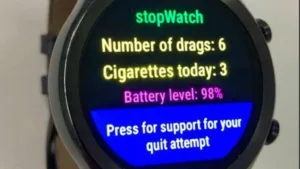What is the best way to quit smoking?
This very question highlights a regrettable lack of understanding in official circles about why smokers smoke in the first place, and how they can quit this abnormal behaviour.
It needs to understood that you don’t need a way, method, or technique to quit smoking. You just need to quit smoking. (The word ‘method’ in the phrase Symonds Method is used merely for convenience.)
Nonetheless, we are informed by the BBC (11 January 2025) that Cancer Research UK has funded a study, as follows:
A new smartwatch app (illustrated) which intervenes when typical hand movements of smoking are detected could help people quit. The app was tested on 18 smokers over two weeks, who wore a Ticwatch with the software installed…Some of the participants found the app effective, researchers said, while others reported the messages were vague.
So that’s what smokers need: non-vague messages!
Vague or not, such an approach is hopeless, since everything in the illustration is wrong. It seems the smoker has had only six drags (a pejorative slang word for puffs) from three cigarettes in the day so far. That’s two drags per cigarette. But smokers are well aware how many cancer sticks they’ve used and can easily count the number of drags they take.
Guilt, disgust, and frustration
You can imagine the poor smoker – I’ll assume a male but it applies equally to females – using this app, desperate for nicotine, only allowing himself to take two drags before throwing the cig away with a mixture of guilt, disgust, and frustration at his unsatisfied need for nicotine, as the app reminds him that he’s failing in his quit attempt. And what sort of support will he get if he presses on the app, as indicated? Here’s an example:
Stopping smoking lets you breathe more easily…Quitting is good.
Now that our smoker has been informed of the obvious, what should he do next? Perhaps it doesn’t really matter, since he’s only making a quit attempt.
I have said it before, but evidently need to say it again. Either you smoke or you don’t, so there’s no such thing as a quit attempt. This means failure to quit as is demonstrated every time the smoker takes another drag on his cigarette.
The conclusion of the study is:
This study shows smartwatches could be a useful method to help people quit smoking…But more research is needed to understand how effective the apps are.
So that’s what we need: more research!
Making it more difficult
I trust readers will forgive me if I sound cynical, but Cancer Research UK just doesn’t get it. They have a section on their website intended to help smokers quit, but it’s discouraging that they rub it in how difficult this will be (slightly paraphrased):
Stopping smoking can be difficult at first. The nicotine in tobacco is addictive, so going without it can cause uncomfortable withdrawal symptoms such as:
Feeling depressed, anxious, irritable, restless or hungry; poor concentration; poor sleep at night; urges to smoke; feeling sick; feeling unwell; and headaches.
Stop smoking tools can ease withdrawal symptoms and specialist support can help you to cope with them until they pass.
As I have already pointed out, this is grossly exaggerated or untrue. If smokers were really to suffer these symptoms, they would be ill, and it’s no wonder many smokers have condemned themselves to smoke for the rest of their lives rather than cope with withdrawal symptoms.
A better way
With the hundreds of smokers I have treated with the Symonds Method, none needed stop smoking tools – nicotine products and prescription drugs – to help them cope.
So, what happens when a smoker stubs out their last cigarette? Nothing much – except a feeling of elation from at last getting the horrid Nicotine Monkey off their back for good.
Text © Gabriel Symonds
Picture credit: bbc.com


Leave A Comment